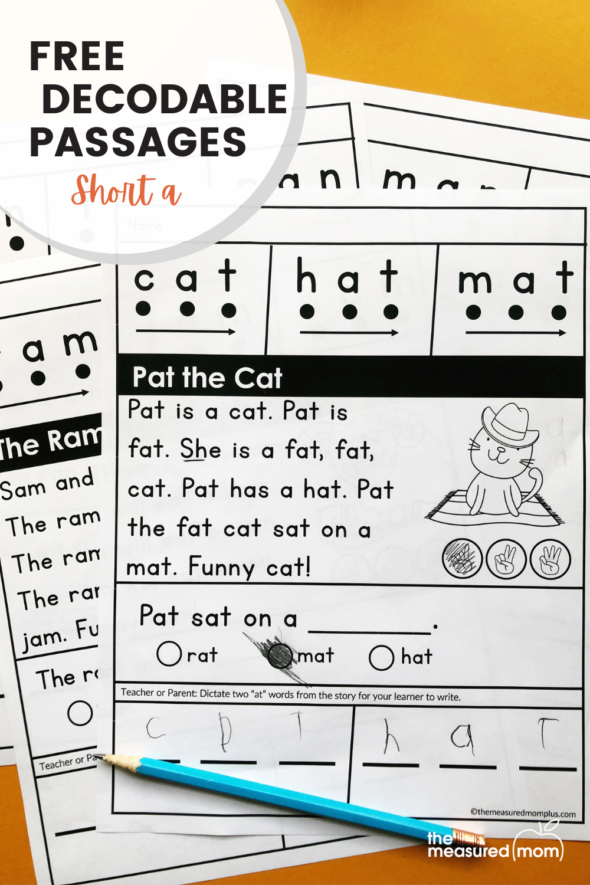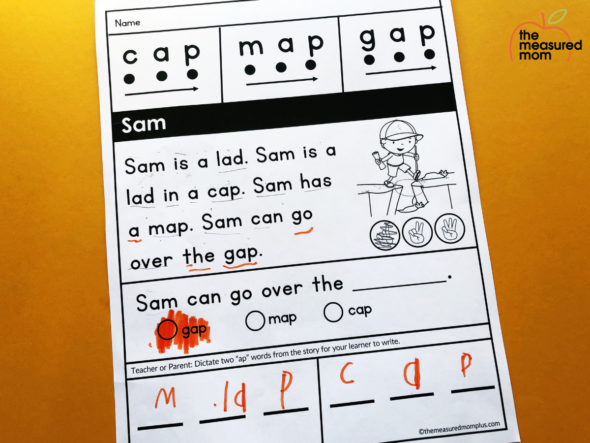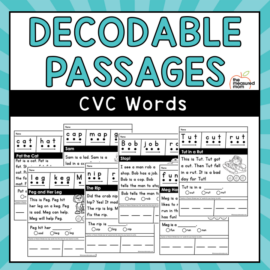Free decodable passages for short a CVC words
This mail contains affiliate links. As an Amazon Associate I earn from qualifying purchases.

So.
These days I've been doing a lot of research into how our brains acquire to read.
In doing that, I've made a shift in how approach beginning reading.
I used to ascribe to the iii-cueing-systems model. It'due south the idea that kids solve unfamiliar words past using iii cues: what looks right (phonics), what sounds right (syntax) and what makes sense (semantics).
Here'southward the problem with the 3-cueing approach.
Researchers are telling united states of america that for kids to read and retrieve words, they need to connect the sounds of the letters to the words on the page. When nosotros bypass that (by first encouraging kids to employ movie or context clues), we're actually preventing them from doing this of import work.
(That important work is calledorthographic mapping, only we'll relieve that for another post!)
To exist clear, kids might USE motion-picture show and context as their first become-to when they approach words, but this isn't how we should TEACH them to approach words. We want to put their attention directly on the words themselves.
This ways that as I'g instruction my youngest to read (he just turned five), we're focusing much more on decodable books than on the sight word and leveled books I used with his older siblings.
(Desire to follow me on my science of reading journey? This podcast episode will get you started.)
Hither's what'south hard about this phonics-first arroyo.
It feels ho-hum.Painfully slow.
When kids read anticipated text and leveled books, they read very quickly and fluently. That'due south because they memorize the pattern and then use the picture show to fill in the last word. Technically, they're not reallyreading at all.
Merely it feels like they are. And it looks similar they're making fast progress. (Until you ask them to read those words without the flick clues and predictable text.)
And so how do we make the shift to more decodable text for beginning readers?Especially when it feels so slow.

Well, the first matter to recall is that nosotrosbuild up to sentences, books, and passages.
My little guy is in preschool. He has been reading CVC words for a couple of months now. About a month agone we started reading decodable books (Flyleaf are our accented favorite then far), and now I'm starting to do passages with him.
Here'south the thing nearly decodable passages.
They'rework.
You demand to expect that they're going to exist work, and that information technology'south okay. But y'all don't desire to overwhelm beginning readers.
Here's a video of my picayune guy's first endeavor at reading one of these passages.
To build fluency with decoding, he'll need to reread this passage. But one reading was plenty for the first time!
Here's the "why" backside the passages:
- The top of each passage includes iii words to audio out. The dots and arrows provide guidance for blending practice.
- Each story is just a few lines on purpose. Trust me, this volition feel enough long to new readers who have to sound out nearly every discussion!
- I do include words that are either temporarily or permanently phonically irregular. In other words, the reader may not be fix (or able) to sound them out. This is intentional. It keeps the texts readable and allows them to sound the style we speak.
- The comprehension question encourages the reader to think well-nigh what s/he but read.
- The spelling exercise at the bottom is important! Information technology helps kids with the process of orthographic mapping: making these words a permanent part of their sight give-and-take vocabulary.

Get your free phonics passages hither!
Get the total fix of passages!

Decodable Passages: CVC Words
$5.00
You'll get all 23 short vowel passages in this cheap parcel.
Source: https://www.themeasuredmom.com/free-decodable-passages-for-short-a-cvc-words/
0 Response to "Free decodable passages for short a CVC words"
Post a Comment